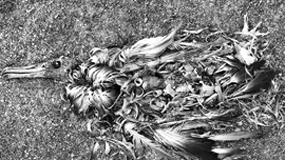
Artist and photographer Chris Jordan heard a rumor about an island of trash, floating around the ocean, twice the size of Texas. He thought to himself, “That’s unbelievable. I should go photograph this thing,” only to learn he couldn’t photograph it because most of the waste was underwater, invisible to humans sailing through it.
It was from this starting point that Jordan went on to learn about the problems of baby Albatross dying on Midway Atoll. Midway Atoll is an island more than 2,400 miles from any large landmass (the nearest being Alaska) and more than 1,000 miles from any city (Honolulu being the closest).
Geographically speaking, this makes it one of the remotest places on our planet and yet 40 percent of all baby Albatross born there every year die from the ingestion of plastic their parents feed them, having found it in our oceans.
Not quite believing what he was being told and shown, Jordan set out to see for himself and take his own pictures. He found and photographed the decomposing carcasses of baby Albatross, only to find that what wasn’t decomposing at all was the plastic still evident in their stomachs (pictured below).

This story got Arthur wondering about our own community. We spoke with Dr. Brad White, who was part of the Wildlife Symposium that recently took place at Trent.
He told us when it came to Peterborough, “This area will soon be the focus of considerable development as the Toronto area continues to expand. Loss of habit and habitat fragmentation will impact wildlife and convert the area into one resembling Southern Ontario. The area like much of Canada will experience climate change and this will mean the movement of a range of animals and plants northward and hybridization of species such as Northern and Southern flying squirrels. In general the area will lose biodiversity in ways already experienced by areas with denser populations like European countries.”
Particularly concerning for Peterborough is, of course, our river. Dr. White told us, “As more housing and cottage development occurs on and around lakes feeding into the watershed, there will be more effluents. There will be more recreational pressure on these areas. At a time when we need more resources to protect natural resources, funding is being reduced.”
Dr. White expressed with this sentiment much concern that as we increase our reasons to protect our waters we’re limiting the organizations which might help, thus taking further risks.
Dr. White went on to say, “The biggest invisible [environmental danger] is greenhouse gases that are changing climate. Many of these gasses are produced elsewhere, like Asia, as a result of North American consumerism. We are thus exporting point pollution to developing economies, so it is important to think well beyond Peterborough; our footprint is not just local.”
Having learned a little about the issues our next question was along the lines of, “What can we do?”
The answer was, “[Remedies] must involve a large change in our way of life to reduce the footprint and waste. The life on the planet has evolved to produce cycles like carbon and nitrogen cycles. In the case of plastic we take fossil fuel carbon and turn it into plastic. There has not been time to evolve biological systems to recycle this plastic by breaking the synthetic bonds in plastic. We need to develop complete cycles for all products so they can be completely recycled back to their components. Recycling is a good first step, but producers must make products that can be entirely recycled at the molecular level.”
Going back to what Jordan was working on, Dr. White told us, “I was involved in the restoration of Hamilton Harbour Project. We concluded the success of the project would be reflected in the plays, poems, and songs written about the harbour. As part of our communication group, we had a theatre group traveling around Hamilton. The Arts are very important to communicate, lead, and reflect.”
In conclusion of the interview, Dr. White noted, “North America must consume less. The dolphin I work on in Taiwan utilizes a habitat adjacent to the largest coal fired electric plant in the world. It feeds massive plastic factories that export to China that makes products for Walmart, Costco, and Target. There is a direct connection to buying a flatscreen TV in Costco that impacts the flying squirrels of Peterborough. We are blessed in this region, but our footprint is global and Toronto is rapidly expanding into this area.”
When the research is so conclusive on so many areas and issues in the environment and the production of consumer goods, it’s confusing that these problems aren’t attacked, solved, or made taboo to be complacent about. It’s strange that it’s still okay to not care, still possible to not care.
Perhaps the ability of our society to remain complacent in the face of floating islands of trash and dead baby birds is caused by the distance of these problems. It’s not in front of our eyes, so it’s not at the forefront of our minds. However, as Dr. Brad White makes clear, this attitude cannot continue. And as Chris Jordan discovered at Midway Atoll, by the time we can see the problem, the damage is already unspeakable.
You can look at more of Chris Jordan’s pictures of the Albatross here.
